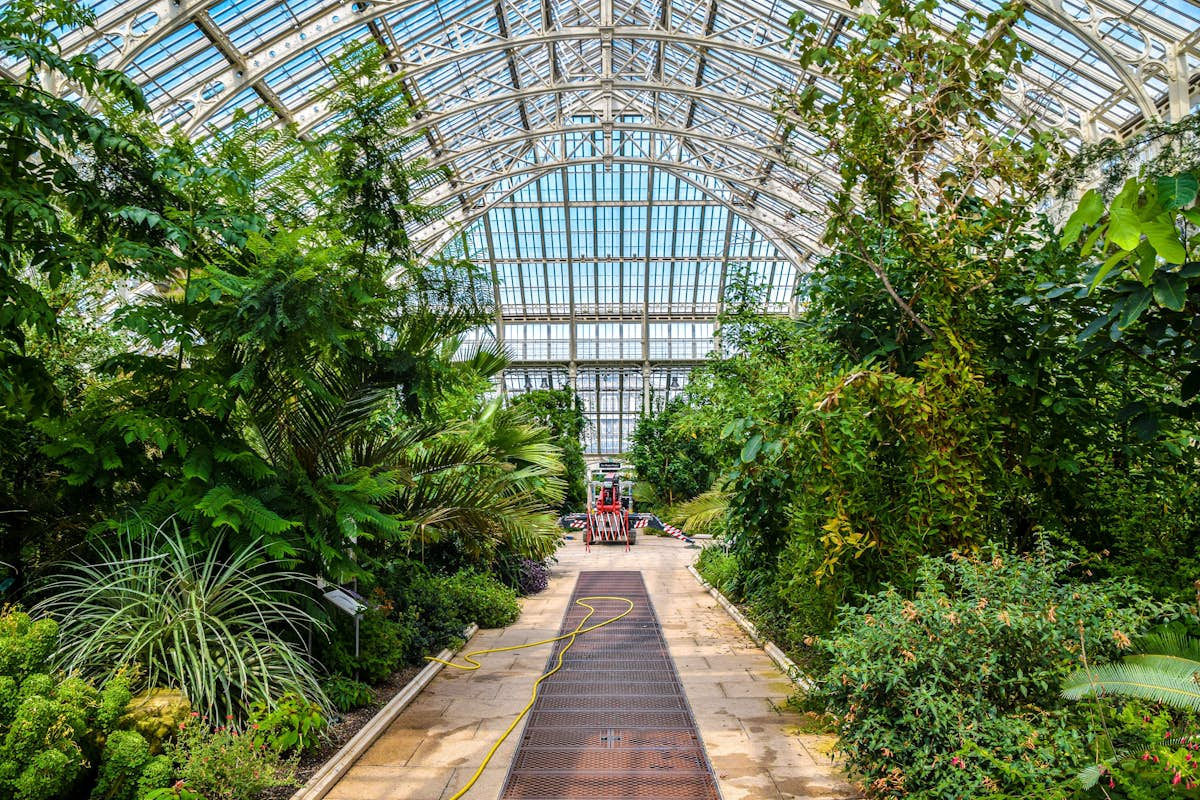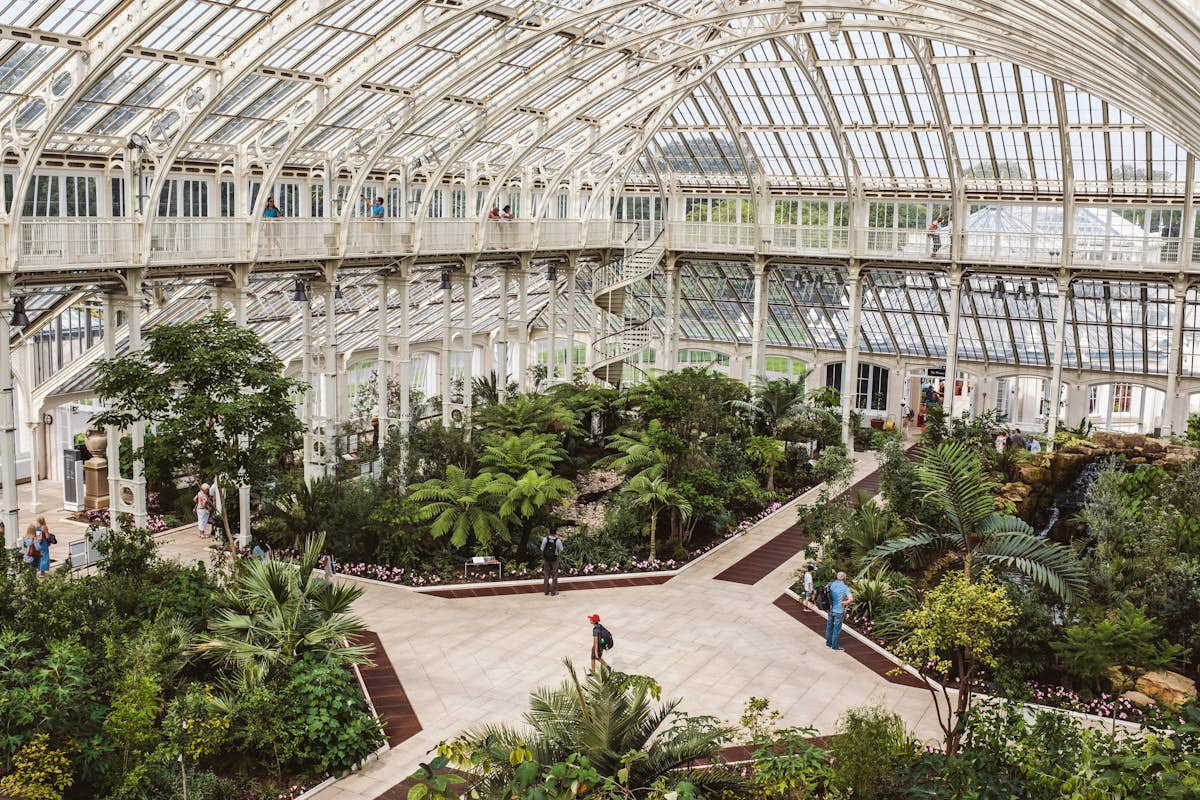The Kew Gardens is an 18th century botanical garden housing the “largest and most diverse botanical and mycological collections in the world”. It occupies a whopping 330 acres and houses 27,500 taxa of living plants, a herbarium of 7 million dried species, over 7,50,000 volumes and illustrations in its library and a vibrant collection of tropical orchids, succulents, tropical ferns, and Australian plants. In 2003 Kew Gardens was designated a UNESCO World Heritage site.
The Kew Gardens has four entrances as it covers a vast expanse of land and having just one entrance is simply not practical. The most famous (and most commonly used) Kew Gardens gate is the Victoria Gate. Here’s everything you need to know about all four of the Kew Garden entrances.

Kew Gardens Entrances | All Entrances Explained
Since the Kew Gardens span 330 acres, there are four different gates that visitors and tourists can choose to enter from:
Victoria Gate
The Victoria Gate is the most famous Kew Gardens Entrance.It is towards the garden's south and 500m from the Kew Garden station. The famous Victoria Gate Cafe welcomes you as you enter from this gate.
What’s near this entrance?
Palm House, Victoria Gate Cafe , The Botanical, Rose Garden, Waterlily House, Temple of Aeolus, Temple of Bellona, Temple of Arethusa.
Quick tip
- Bus number 65 stops right outside this gate.
- You can also sign up for free guided tours that start from Victoria Gate.
Lion Gate
The Lion Gate is the only gate that gives an entry to the south corner of the botanic garden. It is 1 kilometre from the Richmond station. This gate allows quick access to the famous Great Pagoda. The Great Pagoda is a Chinese architectural masterpiece designed by Sir William Chambers. It was a gift to Princess Augustas, believed to be the founder of the Kew Gardens. It is a tower that gives you a crystal clear view of London.
What’s near this entrance?
Great Pagoda, Temperate House, Marianne North Gallery, Shirley Sherwood Gallery of Botanical Art, Treetop Walkway, Japanese Gateway, Ruined Arch.
Quick tip
Bus number 65 stops right outside this gate
Elizabeth Gate
The Elizabeth Gate is one of the two gates accessible by a bus or a river commute and is to the north of the park. It is approximately 0.8 kilometres from the Kew Bridge station. The Elizabeth Gate is best for those who have a keen interest in plant and plant specimens.
What’s near this entrance?
Agius Evolution Garden & Kitchen Gardens, The Hive, Princess of Wales Conservatory, Herbarium & Library, Nash Conservatory.
Quick Tip
- Buses 237, 267, 110 & 65 stop outside this gate.
- This is the most convenient option for visitors who are using boat services from Westminster.
Brentford Gate
The Brentford Gate is the only gate accessible by bus, car and river commute. The Brentford Gate lies to the west of the Kew Gardens, close to the Kew Gardens Parking lot located on Ferry lane.
What’s near this entrance?
Children’s garden, Queen's garden, Great Broad Walk Borders, Kew Palace, White Peaks family restaurant.
Quick tip
If you’re coming via car, this gate is recommended as it's the only one with a parking lot. Note, there is no coach parking here.
Kew Gardens Entrance Timings
The Kew Gardens are operational on all days of the year. Every Kew Garden Entrance gate is operational at the following hours of the day:
Monday to Friday - 10 am to 7 pm
Saturday & Sunday On weekends - 10 am to 7 pm
On Bank holidays - 10 am to 8 pm
Last entry is allowed into Kew Gardens 1 hour before the closing time.
Kew Gardens Entrance Tickets
Grab Kew Garden tickets online at a discount and skip the hassle of standing in ticket queues on the day of your visit. Here are the top recommended Kew Garden entrance tickets. You can enter from any of the 4 Kew Garden entrances with your online ticket.
Getting To Kew Gardens
There is more than one mode of commute to the Kew Gardens. Check the Kew map before planning your visit. Once you have, here are some of the most workable modes of commute:
By Bicycle
Bicycles are one of the most convenient modes of commuting to the Kew Gardens. The Gardens have enough amenities like racks and lockers to safeguard them.At Elizabeth Gate and Victoria Gate, the racks are inside the gates behind the booths. Have a look at the Kew map to spot the lockers and rack station. If the racks are occupied, you will have to leave your bicycles unattended and must leave them outside at your own risk Note,Roller skates, tricycles, skateboards and scooters are not allowed inside the Kew Gardens.
By Bus
Buses travelling through route 65 are your best option. Bus 65 stops at Victoria Gate, Elizabeth Gate and the Lion Gate. Buses 237 and 267 stop close to the Kew Bridge station, close to Elizabeth Gate. Bus 110 stops close to both Elizabeth Gate and the Kew Gardens station.
By Train
There are 2 train stations a short walk away from Kew Gardens:
The Richmond Station
Get off at Richmond Station and take the route 65 bus heading towards Ealing Broadway. You can hop off either at Lion Gate or Victoria Gate. Richmond station has lift and level access.
The Kew Bridge Station
Hop onto any South West Trains and you will reach the Kew Bridge Station, 800 meters from the Elizabeth Gate. This commute is convenient for those residing at Vauxhall, Clapham and Waterloo. There is no level access at Kew Bridge.
By Tube
The Kew Gardens Station is 500m away from the main entrance at Victoria Gate. You can travel from London to any Kew station using a London Travel Card or Oyster card. The other two relatively close tube stations to Kew Gardens are the Gunnersbury Tube Station (16 mins away) and the Chiswick Park Tube Station (23 minutes away).
By Car
Opt for car travel only if you’re coming early in the day.. Car parking is limited and reserved on a first-cum-first-serve basis. If you plan on travelling later during the day, it’s best to arrive via public modes of transport. If you don’t get a parking spot near Brentford Gate, you’ll have to pay and park around which can work out to be expensive. Parking at Brentford Gate costs £7 per day and the car park closes 30 minutes after the Gardens close. There are 3 disabled access parking bays and a drop-off area at Elizabeth Gate.
What not to miss at Kew Gardens?

Kew Gardens are one of the major tourist attractions and bring in 2.1 million people each year. . Plan your visit and cover all the significant attractions housed within this 330-acre garden. Download the Kew Gardens map and keep it handy, lest you get lost in the greenery.
1. The appealing architecture of the Kew Garden
The Kew Gardens have an amalgam of prehistoric structure and modern-day architecture. Cover the following attractions to experience the architectural beauty of the Kew Gardens:
- The Kew Palace
- The Royal Kitchens
- The Pagoda
- Queen Charlotte's Cottage
- The Orangery
- The Minka House
- The Nash Conservatory
2. Galleries and Museums
The Kew Gardens houses many museums that have several plants and plant species on display. These museums also educate visitors about the good practices of gardening. The stellar collection of museums include the following:
- The Museum No 1
- The Shirley Sherwood Gallery of Botanical Art
- The Marianne North Gallery of Botanic Art
3. Gardens of Kews
Kew Gardens house a variety of plants, flowers and trees. Most of these varieties have a designated area. Some of these collections are housed within glasshouses for better care and protection.
- The Palm House
- The Davies Alpine House
- The Princess of Wales Conservatory
- The Waterlily House
- The Temperate House
4. Adventures & Libraries
Kew Gardens has power-packed entertainment for people of all ages . Here are some fun activities for the adventurous minds and libraries for the book-lovers.
- The Treetop Walkway
- The Rhizotron
- The Sackler Crossing
- The Hive
Tips For Your Kew Gardens Visit

It is necessary to book a slot well in advance as Kew Gardens are never short of tourists and admirers. Here are some quick pointers that will help you have a smooth visit to the Kew Gardens:
- Once you book your slot, you will have 45 minutes from the start time to enter the Kew Gardens. There is no upper time limit, and you can stay inside the Kew Gardens and enjoy for as much time as you like. Always carry your photo ID, membership card or proof of membership.
- It is recommended that you arrive between 10 a.m. and 11 a.m. to give yourself enough time to explore the gardens in their entirety.
- Having a Kew gardens map handy is a wise idea.
- Visit the Kew Gardens during the spring and summer months. It’s a whole lot beautiful.
Rules You Must Know Before Visiting The Kew Gardens
- Pets are not allowed inside the garden
- Plucking flowers or pruning plants is prohibited.
- Be careful while walking. Do not step over plants.
- Remote controlled toys and drones are prohibited.
- Musical instruments and radios are not allowed.
- Littering is strictly prohibited and is a fineable offense.
- Jogging and playing ball games are not allowed.
- Picnics are allowed anywhere in the Kew Gardens, except for in the glasshouses or on planted areas.
- No furniture or barbecues will be allowed past the entrance gates.
All Your Questions Answered About Kew Gardens Entrances
How many Kew Gardens entrances are there?
Which is the main Kew Garden entrance?
Until what time are the Kew Garden entrances open?
Which Kew Gardens entrance should I choose if I'm arriving by bike?
Which Kew Gardens entrance should I choose if I'm arriving by bus?
Which Kew Gardens entrance should I choose if I'm arriving by train?
Which Kew Garden entrance should I choose if I'm arriving by car?
How much does the Kew Gardens entrance fee start at?
Ready to explore London?
Check out the top things to do in London and plan your vacation like a pro! Check out the London Travel Guide packed with itineraries, local recommendations, insider tips & more.


